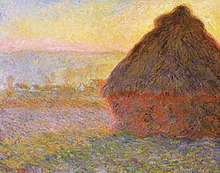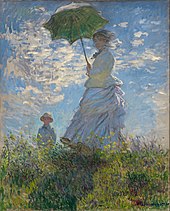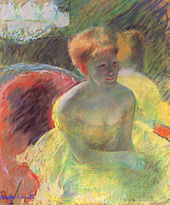Impressionism ii
Impressionism ii
Assignment Submission
Artists' petitions requesting a new Salon des Refusés in 1867, and again in 1872, were denied. In December 1873, Monet, Renoir, Pissarro, Sisley, Cézanne, Berthe Morisot, Edgar Degas and several other artists founded the Société Anonyme Coopérative des Artistes Peintres, Sculpteurs, Graveurs ("Cooperative and Anonymous Association of Painters, Sculptors, and Engravers") to exhibit their artworks independently.Members of the association were expected to forswear participation in the Salon.The organizers invited a number of other progressive artists to join them in their inaugural exhibition, including the older Eugène Boudin, whose example had first persuaded Monet to adopt plein air painting years before.Another painter who greatly influenced Monet and his friends, Johan Jongkind, declined to participate, as did Édouard Manet. In total, thirty artists participated in their first exhibition, held in April 1874 at the studio of the photographer Nadar.
Claude Monet, Haystacks, (sunset), 1890–1891, Museum of Fine Arts, Boston
The critical response was mixed. Monet and Cézanne received the harshest attacks. Critic and humorist Louis Leroy wrote a scathing review in the newspaper Le Charivari in which, making wordplay with the title of Claude Monet's Impression, Sunrise (Impression, soleil levant), he gave the artists the name by which they became known. Derisively titling his article The Exhibition of the Impressionists, Leroy declared that Monet's painting was at most, a sketch, and could hardly be termed a finished work.
He wrote, in the form of a dialog between viewers,
"Impression—I was certain of it. I was just telling myself that, since I was impressed, there had to be some impression in it ... and what freedom, what ease of workmanship! Wallpaper in its embryonic state is more finished than that seascape."
Claude Monet, Woman with a Parasol - Madame Monet and Her Son (Camille and Jean Monet), 1875, National Gallery of Art, Washington, D.C.
The term Impressionist quickly gained favour with the public. It was also accepted by the artists themselves, even though they were a diverse group in style and temperament, unified primarily by their spirit of independence and rebellion. They exhibited together—albeit with shifting membership—eight times between 1874 and 1886. The Impressionists' style, with its loose, spontaneous brushstrokes, would soon become synonymous with modern life.
Monet, Sisley, Morisot, and Pissarro may be considered the "purest" Impressionists, in their consistent pursuit of an art of spontaneity, sunlight, and colour. Degas rejected much of this, as he believed in the primacy of drawing over colour and belittled the practice of painting outdoors.Renoir turned away from Impressionism for a time during the 1880s, and never entirely regained his commitment to its ideas. Édouard Manet, although regarded by the Impressionists as their leader, never abandoned his liberal use of black as a colour (while Impressionists avoided its use and preferred to obtain darker colours by mixing), and never participated in the Impressionist exhibitions. He continued to submit his works to the Salon, where his painting Spanish Singer had won a 2nd class medal in 1861, and he urged the others to do likewise, arguing that "the Salon is the real field of battle" where a reputation could be made.
Camille Pissarro, Boulevard Montmartre, 1897, the Hermitage, Saint Petersburg
Among the artists of the core group (minus Bazille, who had died in the Franco-Prussian War in 1870), defections occurred as Cézanne, followed later by Renoir, Sisley, and Monet, abstained from the group exhibitions so they could submit their works to the Salon. Disagreements arose from issues such as Guillaumin's membership in the group, championed by Pissarro and Cézanne against opposition from Monet and Degas, who thought him unworthy.Degas invited Mary Cassatt to display her work in the 1879 exhibition, but also insisted on the inclusion of Jean-François Raffaëlli, Ludovic Lepic, and other realists who did not represent Impressionist practices, causing Monet in 1880 to accuse the Impressionists of "opening doors to first-come daubers".The group divided over invitations to Paul Signac and Georges Seurat to exhibit with them in 1886. Pissarro was the only artist to show at all eight Impressionist exhibitions.
The individual artists achieved few financial rewards from the Impressionist exhibitions, but their art gradually won a degree of public acceptance and support. Their dealer, Durand-Ruel, played a major role in this as he kept their work before the public and arranged shows for them in London and New York. Although Sisley died in poverty in 1899, Renoir had a great Salon success in 1879.Monet became secure financially during the early 1880s and so did Pissarro by the early 1890s. By this time the methods of Impressionist painting, in a diluted form, had become commonplace in Salon art.
Impressionist techniques
Mary Cassatt, Lydia Leaning on Her Arms (in a theatre box), 1879
French painters who prepared the way for Impressionism include the Romantic colourist Eugène Delacroix, the leader of the realists Gustave Courbet, and painters of the Barbizon school such as Théodore Rousseau. The Impressionists learned much from the work of Johan Barthold Jongkind, Jean-Baptiste-Camille Corot and Eugène Boudin, who painted from nature in a direct and spontaneous style that prefigured Impressionism, and who befriended and advised the younger artists.
A number of identifiable techniques and working habits contributed to the innovative style of the Impressionists. Although these methods had been used by previous artists—and are often conspicuous in the work of artists such as Frans Hals, Diego Velázquez, Peter Paul Rubens, John Constable, and J. M. W. Turner—the Impressionists were the first to use them all together, and with such consistency. These techniques include:
- Short, thick strokes of paint quickly capture the essence of the subject, rather than its details. The paint is often applied impasto.
- Colours are applied side by side with as little mixing as possible, a technique that exploits the principle of simultaneous contrast to make the colour appear more vivid to the viewer.
- Greys and dark tones are produced by mixing complementary colours. Pure impressionism avoids the use of black paint.
- Wet paint is placed into wet paint without waiting for successive applications to dry, producing softer edges and intermingling of colour.
- Impressionist paintings do not exploit the transparency of thin paint films (glazes), which earlier artists manipulated carefully to produce effects. The impressionist painting surface is typically opaque.
- The paint is applied to a white or light-coloured ground. Previously, painters often used dark grey or strongly coloured grounds.
- The play of natural light is emphasized. Close attention is paid to the reflection of colours from object to object. Painters often worked in the evening to produce the shadowy effects of evening or twilight.
- In paintings made outdoors, shadows are boldly painted with the blue of the sky as it is reflected onto surfaces, giving a sense of freshness previously not represented in painting. (Blue shadows on snow inspired the technique.)
New technology played a role in the development of the style. Impressionists took advantage of the mid-century introduction of premixed paints in tin tubes (resembling modern toothpaste tubes), which allowed artists to work more spontaneously, both outdoors and indoors. Previously, painters made their own paints individually, by grinding and mixing dry pigment powders with linseed oil, which were then stored in animal bladders.






